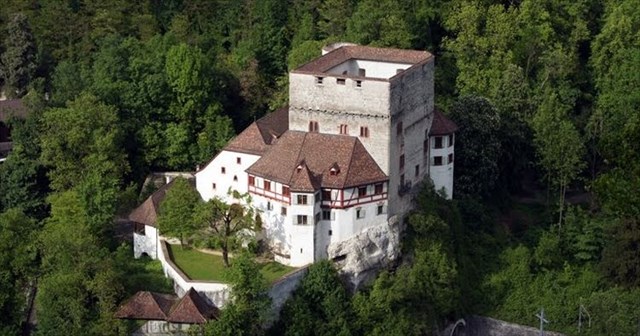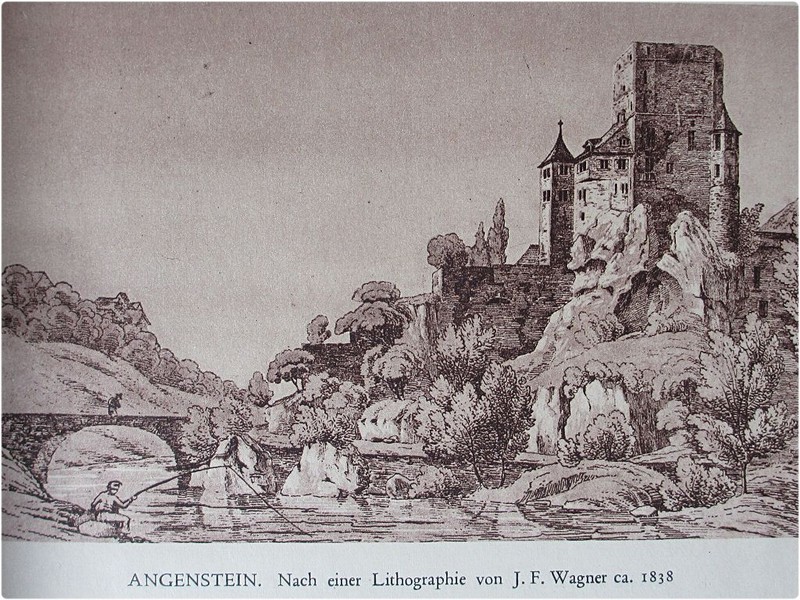DE
Schloss Angenstein, Duggingen

Eingereiht in eine Burgenkette thront Angenstein auf einem breiten Felskopf zwischen Aesch und Duggingen, wo sich die Birs ein letztes mal durch die Jurakette zwängt. Angenstein war als "Vorposten" von Basel und für die Beherrschung des Juragebietes stets von strategischer Bedeutung. Zudem bildete die Birs lange Zeit die Grenze zwischen dem Sisgau und dem Sundgau, also zwischen französischen und österreichischen Herrschaftsgebieten.
Wer der erste Herr von Angenstein war, ist unbekannt. Nach der geschichtlichen Überlieferung steht jedoch fest, dass Angenstein bereits im 13. Jh. zu den Hausgütern der Grafen von Pfirt gehörte. Die Hälfte davon wurde offenbar 1271 an den Bischof von Basel abgetreten. So gelangte Angenstein in die Herrschaft der Grafen von Thierstein, die das Lehen an die Münchs von Landskron übergaben. Als der letzte Münch keinen Erben mehr hatte, ging das Lehen wieder an Thierstein zurück. Nach einem langen Streit zwischen Basel und Solothurn um den Besitz des strategisch wichtigen Vorpostens ging schliesslich der Bischof als Sieger hervor. 1557 übergab er das Lehen seinem Kanzler, dem Advokaten Wendelin Zipper, der heute noch bekannteste Burgherr. Dieser baute die durch Brände (1494 und 1517) zerstörte Burg nach 1557 wieder zu einem ritterlich-romantischen Domizil aus. Er fügte in geschickter Weise dem vierstöckigen Donjon (Wohnturm) die Fachwerkbauten an, die heute noch das Bild von Angenstein prägen. Mit neuen Wohn- und Wirtschaftsgebäuden wurde 1562 die Kapelle nach frühchristlichem Muster erbaut. Deren bedeutenster Schmuck bilden drei prächtige vom Bischof und den Domherren gestiftete Glasfenster, welche die kirchlichen Feiertage "Karfreitag", "Weihnachten" und "Pfingsten" verherrlichen.
Kriegerische Auseinandersetzungen (während des 30jährigen Krieges trieben die Schweden im Birstal ihr Ungemach und besetzten Angenstein), Brände und die Verarmung der wechselnden Besitzer führten in der Folge zur zunehmenden Verwahrlosung. Anfang des 19. Jh. erfolgten noch einmal zahlreiche Veränderungen.

1951 erwarb die Stadt Basel das Schloss Angenstein, das auf Dugginger Gemeindegebiet liegt. 1984 brannte es im Schloss zum letzten Mal. 1988 bis 1991 wurde es total saniert und bewohnbar gemacht. Auch die Kapelle und einige Gesellschaftsräume konnten wieder hergerichtet werden.
Die Schlosskapelle für kirchliche Anlässe aller christlichen Konfessionen und das Foyer mit Office sowie der untere Schlosshof mit Remise können für festliche Anlässe gemietet werden. Auch Apéros und kleinere Sitzungen sind möglich.
Der Kanton Basel-Landschaft bietet die Möglichkeit an, zivile Trauungen im Schloss Angenstein durchzuführen. Auskünfte erteilt das Zivilstandsamt Laufen.
Der Cache
Er sollte eigentlich einfach zu finden sein und könnte sogar als Drive-In geloggt werden. Zu gewissen Uhrzeiten herrscht hier allerdings ein anständiger Durchgangsverkehr mit entsprechendem Muggel-Aufkommen. Das Loggen sollte also mit der nötigen Vorsicht vorgenommen werden.
Bitte gebt Sorg zum Cache und platziert ihn wieder sorgfältig, so dass er lange bestehen bleibt.
Die Gleisanlage müssen und dürfen nicht betreten werden.
Einzelnachweise: Amt für Raumplanung Kanton Basel-Landschaft. Fotos: Baselland Tourismus.
FR
Château Angenstein, Duggingen
Histoire
Angenstein trône dans une chaîne de châteaux sur un large rocher entre Aesch et Duggingen, où les Birs se faufilent une dernière fois dans la chaîne du Jura. Angenstein a toujours été considérée comme un "avant-poste" de Bâle et pour le contrôle de la région du Jura d’importance stratégique. De plus, les Birs ont longtemps formé la frontière entre le Sisgau et le Sundgau, c'est-à-dire entre les dominions français et autrichien.
Qui était le premier maître d'Angenstein est inconnu. Selon des documents historiques, cependant, il est certain qu'Angenstein faisait déjà partie des biens des ménages des comtes de Pfirt au XIIIe siècle. La moitié de celle-ci aurait été cédée en 1271 à l'évêque de Bâle. Alors Angenstein est entré dans le règne des comtes de Thierstein, qui a remis le fief aux Münchs de Landskron. Lorsque le dernier Münch n'avait pas d'héritier, le fief revint à Thierstein. Après une longue dispute entre Bâle et Soleure sur la possession de cet avant-poste d'importance stratégique, l'évêque est finalement sorti victorieux. En 1557, il remet le fief à son chancelier, l'avocat Wendelin Zipper, qui est toujours le seigneur le plus célèbre du château. Cela a construit le château détruit par les incendies (1494 et 1517) après 1557 à nouveau à un domicile chevalero-romantique. Il a habilement ajouté les bâtiments à pans de bois au Donjon (tour d'habitation) de quatre étages, qui caractérise encore l'image d'Angenstein aujourd'hui. Avec de nouveaux bâtiments résidentiels et commerciaux en 1562, la chapelle a été construite selon le modèle paléochrétien. Leurs bijoux les plus importants sont constitués de trois splendides vitraux donnés par l'évêque et les chanoines, qui glorifient les fêtes religieuses "Vendredi saint", "Noël" et "Pentecôte".
Des conflits guerriers (pendant la guerre de Trente Ans, les Suédois à Birstal conduisirent leur affliction et occupèrent Angenstein), des incendies et l'appauvrissement des propriétaires changeants se traduisirent par une négligence croissante. Au début du 19ème siècle, de nombreux changements ont été apportés.
En 1951, la ville de Bâle acquit le château Angenstein, situé sur la commune de Dugginger. En 1984, le château a brûlé pour la dernière fois. De 1988 à 1991, il a été entièrement rénové et habitable de suite. La chapelle et certaines salles sociales pourraient également être restaurées.
La chapelle du château pour les événements religieux de toutes les confessions chrétiennes et le hall avec bureau ainsi que la cour basse avec la remise peuvent être loués pour des occasions festives. Des apéritifs et des réunions plus petites sont également possibles.
Le canton de Bâle-Campagne offre la possibilité d'organiser des mariages civils au château d'Angenstein. Les informations sont données par l'Office d'état civil de Laufen.
La cache
Il devrait être facile à trouver et pourrait même être connecté en tant que drive-in. À certains moments, cependant, il y a un trafic de travers décent avec des aventures moldues correspondantes. La journalisation doit être effectuée avec la prudence nécessaire.
Veuillez prendre soin de la cache et la replacer soigneusement afin qu'elle dure longtemps.
Le système de piste doit et ne doit pas être entré.
Références uniques: Office de l'aménagement du territoire du canton de Bâle-Campagne. Photos: Tourisme Baselland.
EN
Castle Angenstein, Duggingen
History
Angenstein sits enthroned in a castle chain on a broad head of rock between Aesch and Duggingen, where the Birs squeezes through the Jura chain one last time. Angenstein was always regarded as an "outpost" of Basel and for the control of the Jura region of strategic importance. In addition, the Birs formed a long time the border between the Sisgau and the Sundgau, ie between French and Austrian dominions.
Who was the first master of Angenstein is unknown. According to historical records, however, it is certain that Angenstein was already one of the household goods of the Counts of Pfirt in the 13th century. Half of it was apparently ceded in 1271 to the Bishop of Basel. So Angenstein came into the rule of the Counts of Thierstein, who handed over the fief to the Münchs of Landskron. When the last Münch had no heirs, the fief returned to Thierstein. After a long dispute between Basel and Solothurn over the possession of the strategically important outpost, the bishop finally emerged victorious. In 1557 he handed over the fief to his chancellor, the lawyer Wendelin Zipper, who is still the most famous lord of the castle today. This built the destroyed by fires (1494 and 1517) castle after 1557 again to a knightly-romantic domicile. He cleverly added the timber-framed buildings to the four-storey Donjon (residential tower), which still characterize the image of Angenstein today. With new residential and commercial buildings in 1562, the chapel was built according to early Christian pattern. Their most important jewelery is made up of three splendid stained-glass windows donated by the bishop and the canons, which glorify the religious holidays "Good Friday", "Christmas" and "Pentecost".
Warlike conflicts (during the Thirty Years War, the Swedes in Birstal drove their affliction and occupied Angenstein), fires and the impoverishment of the changing owners resulted in the increasing neglect. At the beginning of the 19th century, many changes were made.
In 1951, the city of Basel acquired the castle Angenstein, which lies on Dugginger municipality. In 1984 the castle burned for the last time. From 1988 to 1991 it was totally renovated and habitable. Also the chapel and some social rooms could be restored.
The castle chapel for religious events of all Christian denominations and the foyer with office as well as the lower courtyard with coach house can be rented for festive occasions. Also aperitifs and smaller meetings are possible.
The canton of Basel-Landschaft offers the opportunity to hold civil weddings in Angenstein Castle. Information is given by the Civil Status Office Laufen.
The cache
It should be easy to find and could even be logged as a drive-in. At certain times, however, there is a decent through traffic with corresponding Muggle adventures. The logging should be done with the necessary caution.
Please take care to the cache and place it carefully again so it will last for a long time.
The track system must and must not be entered.
Single references: Office for Spatial Planning Canton Basel-Landschaft. Photos: Baselland Tourism.